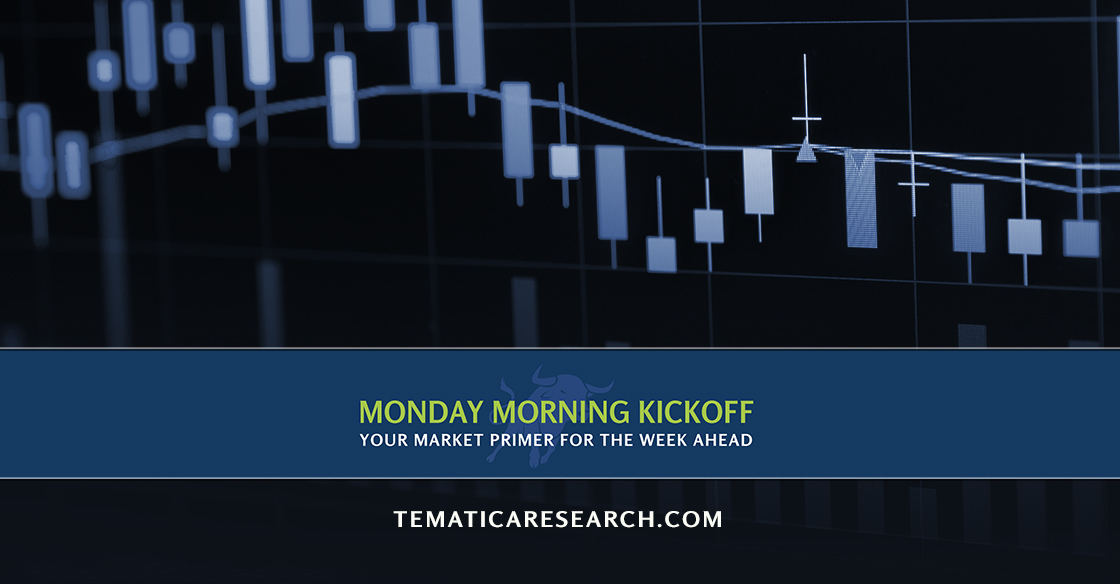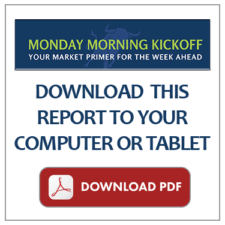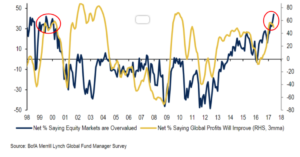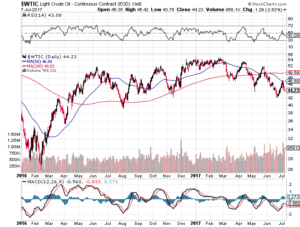We Are Seeing Classic Late-Cycle Signs Everywhere
DOWNLOAD THIS WEEK’S ISSUE
The full content of The Monday Morning Kickoff is below; however downloading the full issue provides detailed performance tables and charts. Click here to download.
We know it’s hard to believe, but we’ve closed out the first week of 3Q 2107. For some, it was a vacation week, for others like those of us here at Tematica it was a busy one. As much as we love a holiday, especially July 4th, the downside is compressing five days of trading, data and other information into what was essentially three days.
It was a busy week from start to finish and ended with the market indices eking out a modest move higher, due primarily to Friday’s better than expected June Employment Report. If you missed that report, you can check out Tematica’s Chief Macro Strategist, Lenore Hawkins beneath the headlines look at the report on TematicaResearch.com.
“You can’t continue to get all this job growth but there is no wage pressure. So something is not adding up at all,”
JJ Kinahan
Chief Market Strategist , TD Ameritrade (AMTD)
The headline jobs figure crushed expectations and job creation figures for April and May were revised higher. Average hourly wage growth, however, in June trailed forecasted levels and May was revised modestly lower. We’d also note that despite the upside surprise jobs number in the June report, the 12-month employment growth rate is still hovering around 1.5 to 1.6 percent, which serves as a reminder the current expansion is getting long in the tooth. All in all, the June Jobs Report was solid, but one that is not likely to lead the Fed to boost interest rate near-term, especially since it’s looking more like it will begin to unwind its balance sheet come September.
Also released on Friday was the Fed’s latest Monetary Policy Report, which added firepower for the Fed to hold steady near-term with regard to interest rates. Specifically, inside the report we found, “Economic activity increased at a moderate pace over the first half of the year” and “on balance, current and prospective economic conditions called for a further gradual removal of policy accommodation.”
To us, this signals that we’re not likely to see the next Fed rate hike until late this year, and possibly even early 2018 at the soonest. Over the coming weeks, we’ll continue to get additional June data points, which should give us more insight for the speed of not only the second quarter but what’s likely to be the start of the third quarter.
So, Magic 8 Ball, Are We Heading into a Recession?
Although we here at Tematica see no signs of an imminent end to this economic cycle, we would remind investors that we are more than eight years into the second-longest bull market in history. On top of that, we’re seeing classic late-cycle signs everywhere — from elevated stock valuations, a flattening yield curve, levered balance sheets and an increasingly hawkish Fed.
Let’s not forget the herd optimism among the Wall Street analyst community, which more often than not tends to be a few beats late on the dance floor. The Bank of America Merrill Lynch’s “Sellside Indicator”, which measures how bullish strategists are on US equities, rose to its highest level since 2011 in June. That compares to the record 44 percent of fund managers that said they saw equities as overvalued in June per the monthly Bank of American Merrill Lynch institutional investor sentiment poll. We’d note not only the sequential increase from 37 percent but also the reading is the highest since the 1999-2001 period.
Digging into the details of the details B of A’s Sellside Indicator, the Nasdaq Composite Index was named the most crowded trade, with 57 percent of investors saying Internet stocks are expensive and 18 percent calling them “bubble- like.’’ If this sounds similar to what you remember hearing back in 2000, let’s remember the collapse in the S&P 500 that occurred from September 2000 until it bottomed in early October 2002.
We see all of this help explain why US equity funds suffered withdrawals in the last week of June, despite the strongest retail inflows since late 2015, according to EPFR Global. Historically speaking, the retail investor tends to pile in late in the cycle more often than not only to be burned.
As we say here at Tematica, “that’s the market”, but not only do we not buy the market, we also don’t subscribe to sector investing. Frankly, we see sector investing like we see “buy and sleep” investing – they’re both dead. We prefer our proprietary thematic framework, and week in week out we continue to find supporting data points for our 17 investment themes. Some of them from this week include:
- Connected Society and Content is King: “last year we saw video growth grow by 75 percent as measured by gigabytes on the network. So as an industry, we always hear that 75 percent to 80 percent of video, of the data on the network in the next five years is going to be video and we’re seeing it play ” — AT&T (T)
- Connected Society: Millennial clients make up 40 percent of new customers at brokerage firm TD Ameritrade (AMTD), with over half of their trades coming from mobile
- Connected Society: Per a new report from Bespoke, 49 percent of 2000 surveyed did not visit a Macy’s (M), Nordstrom (JWM), JC Penney (JCP), Dillard’s (DDS), Bloomingdale’s or Saks in the last month. Where did they shop? Roughly 60 percent of respondents said they bought something from Amazon (AMZN) in the last We expect the mall pain to only accelerate with Amazon’s Prime Day (July 11) as we enter the Back to School and, before too long, year-end holiday shopping season.
- Disruptive Technologies: German auto supplier Robert Bosch shared it has seen a surge in demand for radar systems and video sensors as automakers race to add driver assistance features and automated functions to
- Disruptive Technologies: Volvo (VOLVY) outlined ambitious plans to transition its entire lineup to vehicles powered either by batteries or hybrid electric-internal combustion engines by 2019. While it’s target is less ambitious than that in Norway and India, France announced it would aim to end the sale of gasoline and diesel cars by
- Guilty Pleasures: Amazon is partnering with King Vintners, a subsidiary of Oregon’s King Estate Winery, for Next, Amazon’s private wine label, that is already We talked about this and how it adds yet another thematic tailwind to Amazon on last week’s podcast.
What’s that About 2Q 2017 EPS Growth Expectations?
This week will see six S&P 500 companies report quarterly earnings, not quite the deluge, but that will come soon enough. As we say here at Tematica, context and perspective are crucial, and that means getting a handle on what’s expected.
For the S&P 500, the latest view calls for a blended earnings growth rate of 6.5 percent for 2Q 2017. As we shared in past issues of the Monday Morning Kickoff, using the herd’s sector view we see the greatest EPS generator year over year is the Energy sector with a $7.4 billion increase in earnings. Keep in mind, in 2Q 2016 Energy earnings were scant and over the last year, we’ve seen a renaissance of sorts in domestic oil production.
Now here’s the thing, if we were to exclude the Energy sector entirely, the blended earnings growth rate for the remaining ten S&P 500 sectors would fall to 3.7 percent from 6.5 percent. While we haven’t done the mental math for what that impact would be on the expected 11 percent earnings growth rate currently had for the second half of 2017 vs. the first half, there is little question that 11 percent would be far lower.
The reality is we can’t exclude the Energy sector, but (and it’s kind of a big but), we have seen oil prices fall of late compared to both 1Q 2017 and the average price had in 2Q 2016. That sell-off — a reflection of both increasing supply as well as slowing demand — is beginning to flow through to Wall Street cutting expectations on energy producers ranging from Exxon Mobil (XOM) to Marathon Oil (MRO) as well as shale plays, Continental Resources (CLR) and EOG Resources (EOG). Odds are when these companies report, they’ll be trimming back earnings expectations for the back half of the year given the pullback in oil prices as well as recent reports that Russia will oppose any proposals to deepen the existing production-cut agreement. Candidly, we’re beginning to wonder how much longer that production cut agreement will last given the news that OPEC exports increased by 450,000 barrels per day month-over-month in June; historically speaking, these production cut agreements tend to last only so long until a few bad actors favor their own country’s needs vs. the OPEC agreement.
“Not yet, but if this continues to go like this where no major legislation is passed. It will impact confidence, there is no question about that.”
Gary Burnison
CEO Korn Ferry International (KFY)
As it stands today, the EPS expectation for the S&P 500 calls for 11 percent growth in the second half of 2017 vs. the first half, well above the 5.6 percent average of the last several years. That 11 percent breaks down as follows: for 3Q 2017, analysts are projecting earnings growth of 7.3 percent and revenue growth of 5.1 percent. For 4Q 2017, the metrics are earnings growth of 12.4 percent and revenue growth of 5.1 percent.
Not to be overly repetitive, but we see a greater probability that these expectations come down as companies and investors revisit initial forecasts given the current vector and velocity of the economy, uncertainty over Trump policy timing as well as potential trade issues like a ban on steel imports and Canadian lumber tariffs (see last week’s Cocktail Investing Podcast for more on that and what it likely means for US home builders).
This has us thinking we could very well see volatility creep back into the market over the coming weeks.
Turning to the Week Ahead
After a data packed, holiday-shortened week, this week we start to see more 2Q 2017 earnings trickle in as well as several key pieces of June economic data including Retail Sales and Industrial Production. We’ll also get the Fed’s latest anecdotal take on economic conditions in its latest Beige Book and the latest inflation data, both of which will be eyes ahead of the Fed’s July 25-26 FOMC meeting.
After having just boosted rates, and signs of more deflation than inflation and suspect economic data, as we shared above odds are the Fed will stand pat on rate hiking until later this year. We will, however, be looking for more insight as to its plans to unwind its balance sheet come September, which much like interest rate hikes will be akin to taking the Fed’s foot off the gas pedal. Expect Tematica’s Chief Macro Economist, Lenore Hawkins, to tackle this with her usual zest and zeal as we push deeper into the summer.
During the upcoming week, just six S&P 500 companies (including one Dow 30 component) are scheduled to report results for the second quarter. This means we don’t expect any major revisions just yet to earnings expectations and what that likely means for the market’s valuation as well as volatility. With reports poised to ramp dramatically starting on July 17 and remain heavy through August 4, we see those three weeks as the ones to watch when it comes to what’s next for the market.
From a Tematica Select List perspective, we have no companies reporting this week, but we will be watching a number of reports that will shed some insight on positions that are on the list. Reports that fall into that category include Taiwan Semiconductor (TSM) and PepsiCo (PEP) as well as National Beverage (FIZZ). Taiwan Semiconductor and its capital spending plans for the back half of the year should offer some insight on the current semiconductor capital equipment upcycle that is part of our Disruptive Technologies investing theme. With PepsiCo and National Beverage, we’ll be examining the shift away from sugar to alternative, healthier sweeteners, as well as other recipe changes as those companies and others like them, look to ride our Foods with Integrity tailwinds.
Other company reports we’ll be mining for data points when it comes to our Economic Acceleration/Deceleration theme as well as the vector and velocity of the domestic economy investing theme include Fastenal (FAST) and MSC Industrial (MSM) given the wide industrial customer base they serve. With the proximity to reporting, we’ve seen a noticeable downshift in investor conferences and we expect them to be few and far between until September — it is the summer and that means Wall Street will slow considerably after the first week in August, which is when corporate reporting will begin to slow.




